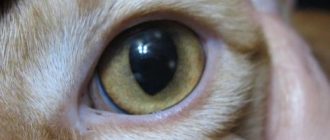Can dogs and cats be friends? Yes, some of them may, but mostly there are always fights and fights between them. Why so is such a mismatch and unwillingness to live peacefully? maybe the problem is that they use different languages. Cats and dogs communicate with us (and among themselves) – using body language. It is important for us understand him, to know what our beloved pet wants. Some movements of cats and dogs may be the same, however their meaning is completely different. This must also be considered when determining the desires of the pet.
How to understand what cats and dogs tell us?
Contents
A cat talks about one thing, but your dog talks about something completely different. Here are some examples of the same behavior of dogs and cats, which when communicating with us can mean completely different things.
Differences between the body language of cats and dogs:
- Tail high: when a cat holds its tail high, it says that she is friendly and demonstrates your relaxation. The higher the tail, the more confident the cat. But if her tail is raised high and the hair is swollen, which means a cat Alarmed or she feels potential aggression. When she become calm – the tail is released a little lower. When the dog keeps her tail high, it indicates that she is excited and ready for aggressive behavior. If she is energetic waving its tail, one must be prepared for her attack. Usually dogs keep the tail in a neutral position when they are relaxed.
- Tail wagging: when the dog wags its tail on average level is a manifestation of friendliness when a cat wags its tail in the same position – this is not a manifestation of goodwill, and desire to attack a person (animal).
- Closed mouth: in relaxed cats, the mouth is always closed, and dogs may be slightly ajar. If the dog’s mouth completely closed, which means it is tense.
- Ears on greeting: if cats hold their ears forward and straight – that means greeting with them will go smoothly. If your ears twitch and bend a little – the cat is not ready for joyful greetings. In dogs, the opposite is true: if the ears are lowered to the side or back – that greeting with a person will be great, if the ears are clearly straightened up – meaning the dog is not happy to see you and is not ready show humility.
- Body tilt sideways: both dogs and cats do such movements when trying to destroy a potential threat. Dogs can to do this in order to show that the enemy is neutralized, while time as a cat thus tries to seem even bigger and formidable.
- Lying position: most likely, the dog is lying on his back in order to show a person his humility and friendliness. Also, being in this position, the dog wants the person rubbed her stomach. If the cat lies on its stomach – this is the first sign self defense. She, as it were, says to everyone standing nearby that she has four paws with sharp claws, and that with their help she is ready to meet any threat. On a man’s attempt to stroke his stomach, a cat reacts aggressively.
The similarities between the body language of cats and dogs:
Sometimes cats and dogs speak the same language. Some movements cats and dogs mean the same thing, here are some examples for confirmation of this:
- Ears are upright: if dogs and cats are relaxed, their ears directed forward. If they are excited by something or interested – ears are constantly mixed from vertical forward position, and this movement is repeated. If the ears are laid back, then they are either scared or dreaming.
- Raised coat: if dogs and cats are scared, their hair become on end (over the entire area of the body, including the tail).
- Pupil dilation: if a cat prepares to attack, her pupils are enlarged. The same thing happens with dogs. Yet dilated pupils indicate their excessive agitation.
- Choking: when the dog and cat are very, very scared, they start to choke slightly. It also happens if they are something are sick.
- Yawning: to calm a dog’s conflict and cats may start to yawn. They also do it for removal. accumulated stress.
Conclusion
If you correctly perceive all the movements of these animals, then you can quickly and correctly assess the situation and make relevant findings. Between a dog and a cat has long been laid aggression. However, there are many examples of how cats and the dogs sleep together nearby, eat from the same bowl and play together different games. And the language barrier does not bother them at all. Take care your pets and watch their behavior. Their body language can tell you a lot. Perhaps you yourself will notice some features in the behavior of your pet.






